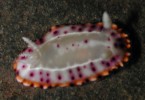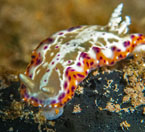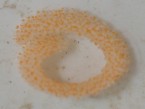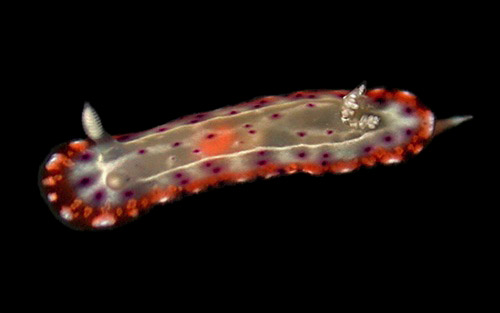_______________
Additional Photos

underside

few spots

many spots

with white spots

young

feeding

mating

egg mass
_______________
GALLERY

|
Goniobranchus decorus (Pease, 1860)

Maximum size: 20 mm.
Identification:
This
species
can vary in pattern but can usually be
identified by its translucent body with a
white median line that bifurcates midway along the notum to form a "Y"
that circles around the gills. Another white line forms a loop around
the median line. There is a marginal orange band and the notum is
decorated with large purple
spots. Mantle glands can often be seen
around the margin beneath the orange border. The rhinophores are cream
shading to light brown in older animals. The branchia are cream
shading to white.
Natural history:
Goniobranchus decorus
is a common species although it is seldom seen due to its small size
and nocturnal habits. It may be found in tide pools and from the low
intertidal to 10 m (32 ft) on protected to exposed rocky
bottoms. It feeds primarily on a thin, black sponge. Its
egg mass is pale orange and each egg is associated with a small cap of
dark orange extra-capsular yolk.
Distribution:
Big Island, Maui, Oahu, Kauai, Niihau, French Frigate Shoals, Midway and Kure (also Johnston Atoll): widely
distributed in the western and central Pacific.
Taxonomic notes:
This species is listed as Chromodoris decora (corrected in 2019 printing) and referred to as
the "decorated nudibranch" in Hoover, 1998 & 2006. It's also listed as C. decora in Bertsch & Johnson, 1981, Kay, 1979 and Kay & Young, 1969. It was first
reported from Hawaii in Pease, 1860 (as Doris decora). The name means "pleasing."
Photo: PF: Maalaea Bay, Maui; July 12, 2024.
Observations and comments:
Note
1: ( )
|
|









